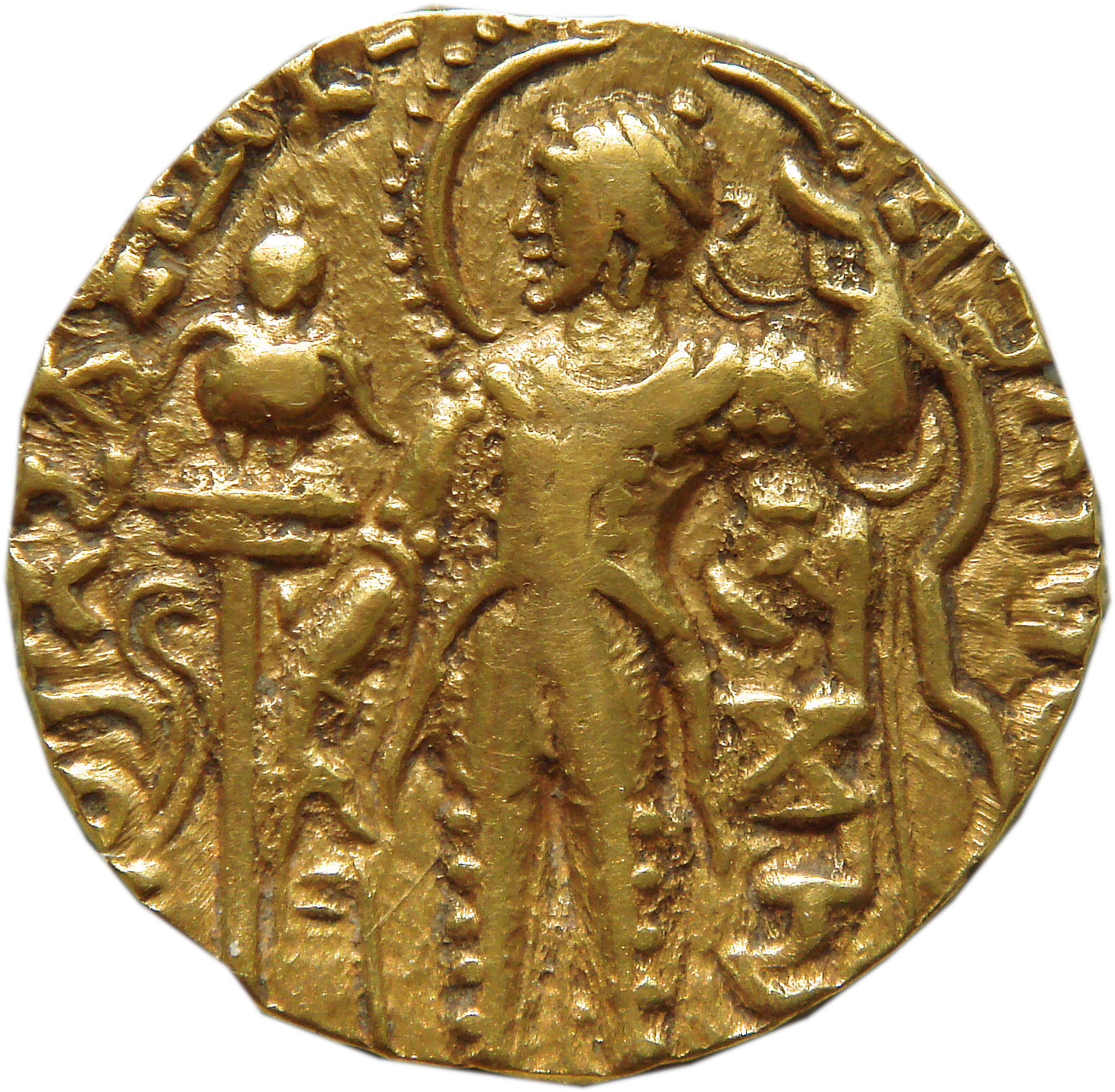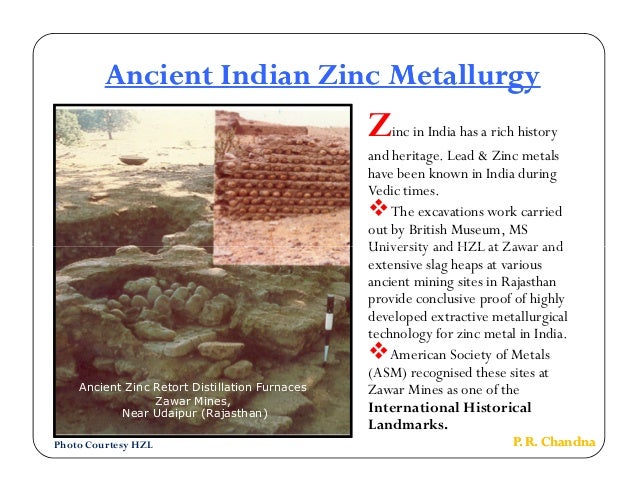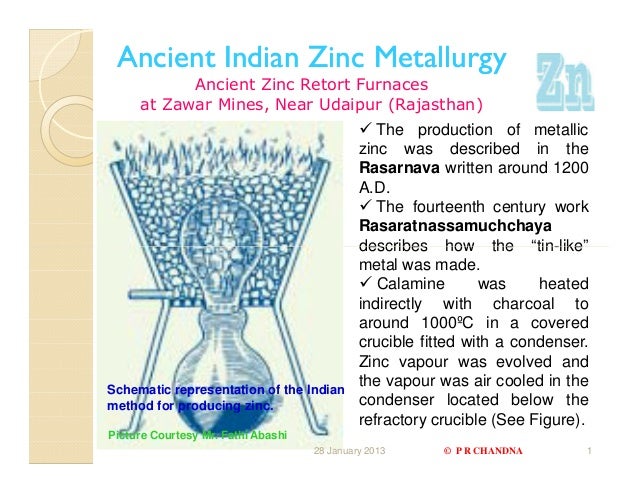
The history of civilization is in many ways linked to the story of the use of metals in antiquity. Although modern metallurgy has seen an exponential growth since the Industrial Revolution it is interesting that many modern concepts in metallurgy have their seeds in ancient practices that pre-date the Industrial Revolution. Metals were extracted and utilized in the past in stages progressing usually from the use of native metal, to those metals which could be smelted easily from ores, to those which were more difficult to smelt. The commonly used metals in antiquity include gold, silver, copper, iron, tin, lead, zinc and mercury. This brief review takes a synoptic look at some aspects of the early use of metal in a global perspective. It throws light on some of the achievements of ancient Indian metallurgists. Its heritage in metallurgy, medicine, mathematics and astronomy is a matter of pride for India.

Gold and Silver
- The noble metals, gold and silver,
are found in the native state, and as is well known, gold and silver were
used to make jewelry and sheet metal due to the great ductility and lustre
of the pure metals.
- Early gold and silver ornaments
from the Indian subcontinent are found from Indus Valley sites such as
Mohenjodaro (ca 3000 BC). These are on display in the National Museum, New
Delhi.
- India has the distinction that the
deepest ancient mines in the world for gold come from the Maski region of
Karnataka with carbon dates from the mid 1st millennium BC.
- A rather delightful piece of
conjecture is that tales of Herodotus, the Greek, about gold-digging ants
from India refers to marmot, a type of rodent found in Afghanistan, who
dig up the river sand which could then have been panned for gold by the
inhabitants.
- Prof. R.K. Dube has produced
literary evidence that the ants gold, refer to in the epic Mahabharath
must have been actually produced by ants, if the size of the gold powder
is any indication.
- The granulation technique
was used to make gold jewelry in India in the late 1st millennium BC
to early Christian era.
- Interestingly, as far as silver
production goes, the Aravalli region in north-west India along with
Laurion in Greece and the Roman mines of Rio Tinto in Spain ranks amongst
the few major ancient silver producing sites from about the mid 1st
millennium BC onwards.
Zinc
- The earliest firm evidence for the
production of metallic zinc is from India.
- Of the metals used in antiquity
zinc is one of the most difficult to smelt since zinc volatalises at about
the same temperature of around 1000oC that is needed to smelt
zinc ore. As a result it would form as a vapour in the furnace which would
immediately get reoxidised and hence lost.

- Hence metallic zinc is seldom
reported in antiquity. However in India there is unique evidence for the
extensive and semi-industrial production of metallic zinc at the Zawar
area of Rajasthan.
- An ingenious method was devised of
downward distillation of the zinc vapour formed after smelting zinc ore
using specifically designed retorts with condensers and furnaces, so that
the smelted zinc vapour could be drastically cooled down to get a melt that
could solidify to zinc metal.

- The Rasaratnakara, a text ascribed to the great Indian scientist Nagarjuna, of the early Christian era describes this method of production of zinc.
Another remarkable artistic
innovation by Indian metalworkers of the past was the use of zinc in making
highly elegant bidri ware, an inlayed zinc alloy, which came
into vogue under the Muslim rulers of the Bidar province in the Hyderabad
region from about the 14th century. AD.
Several impressive vessels,
ewers, pitchers, vessels, huqqa bases etc. were made of bidriware
with patterns influenced by the fine geometric and floral patterns and inlayed
metal work of the Islamic world where decorative metalwork reached some its
most exquisite heights, for instance in the metalwork of the Ottoman empire.
Iron
- Iron seems to have been used in
India from about the late second millennium BC and iron smelting and the
use of iron was especially well established in the south Indian megalithic
cultures of this period.
- The forging of wrought iron seems
to have reached its zenith in India in the first millennium AD.
 |
- The earliest large forging is the
famous iron pillar at New Delhi dated by inscription to the
Gupta period of the 3rd c. AD at a height of over 7 m and weight of about
6 tons. The pillar is believed to have been made by forging together a
series of disc-shaped iron blooms. Apart from the dimensions another
remarkable aspect of the iron pillar is the absence of corrosion which has
been linked to the composition, the high purity of the wrought iron and
the phosphorus content and the distribution of slag.

- We may mention high-carbon steel
from India and cast iron from China, both of which required higher furnace
temperatures and more reducing conditions than the bloomery iron process.
Cast iron was produced in China prior to other parts of the world in small
blast furnaces which were precursors to the modern blast furnaces.
- The famous Mysore Palace in Mysore near Bangalore built by the Wodeyars at the turn of the century was the first royal palace in India to make use of cast iron in architectural construction.
Steel
- India has been reputed for its
iron and steel since Greek and Roman times with the earliest reported
finds of high-carbon steels in the world coming from the early Christian
era, while Greek accounts report the manufacture of steel in India by the
crucible process.
- Wootz is the anglicized version
of ukku in the languages of the states of Karnataka, and
Andhra Pradesh, a term denoting steel.
- Literary accounts suggest that
steel from the southern part of the Indian subcontinent was exported to
Europe, China, the Arab world and the Middle East.
- In the 12th century the Arab
Idrisi says "The Hindus excel in the manufacture of iron. It is
impossible to find anything to surpass the edge from Indian steel".
Mercury
- Mercury is a metal that has been
of great alchemical importance in ancient times.
- Some of the earliest literary
references to the use of mercury distillation comes from Indian treatises
such as the Arthashastra of Kautilya dating from the late first millennium
BC onwards.
In India, vermilion or
cinnabar i.e. mercuric sulphide has had great ritual significance, typically
having been used to make the red bindi or dot on the forehead usually
associated with Hinduism.
Lead
The mineral-rich Aravalli
region of Rajasthan was one of the important early lead mining regions in
antiquity.
Copper
- Early copper artifacts of about the
sixth millennium BC are also reported from the pre-Indus Valley sites of
Baluchistan in the northwestern part of the Indian subcontinent close to
the Iranian border.
- There is also some evidence for
smelting furnaces from the Harappan civilizations of the northwestern part
of the Indian subcontinent.
- There is fairly extensive evidence
for the ancient mining of copper ores from the Khetri region of Rajasthan
in northwestern India dating to about the 3rd-2nd millennium BC.
Tin
- Amongst the earliest bronze
castings in the world is the well executed statue of a dancing girl from
Mohenjodaro from the Indus Valley.
- Some of the most beautiful and
well executed bronze castings in the world are the icons from the Chola
period in the Tanjavur area of south India (ca 10th c. AD).
- South Indian bronzes were mostly
solid cast whereas images from Southeast Asia are mostly hollow
cast.
- Mirrors were made of bronze in
different part of old world including India.
- Investigations show that that the
earliest and continuing use of artifacts of rapidly quenched high-tin
bronzes is from the Indian subcontinent.
Conclusions
- We see there is growing evidence
to suggest that ancient Indian metallurgists have also made major
contributions which deserve their place in the metallurgical history of
the world along with other great civilizations of the world.
- As clearly seen in the case of
zinc and high-carbon steel, ancient India contributed significantly to
their modern metallurgical advances and in the development of
metallurgical study leading to the Industrial Revolution in Europe and
hence deserve a special niche in the annals of western science.
- Metal can just as well be used to
assay the progress of mankind. In this assay the ancient civilisation of
India acquits itself with glory.

